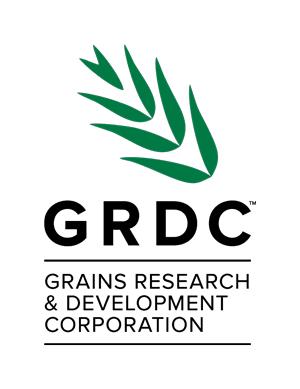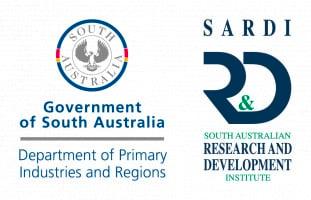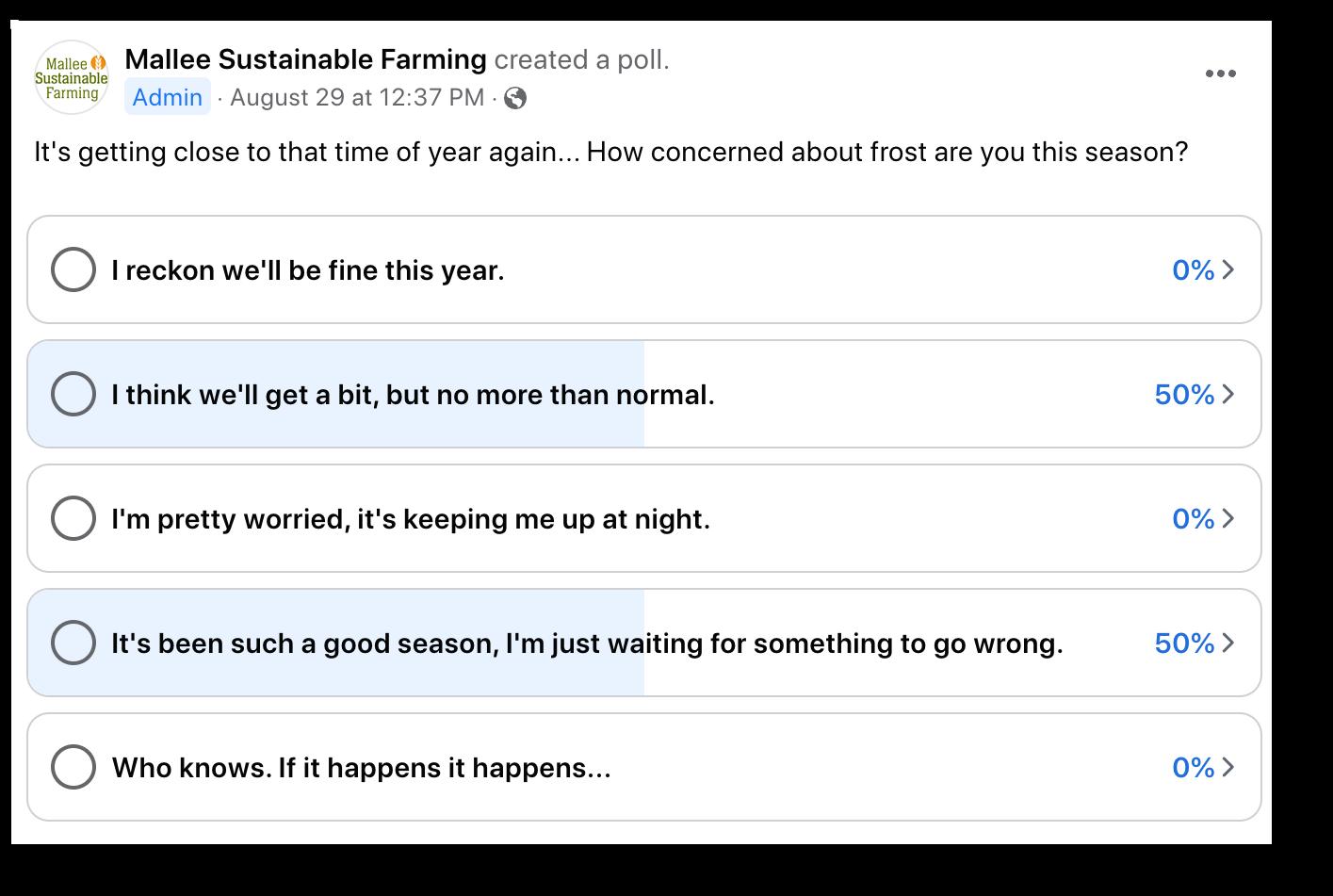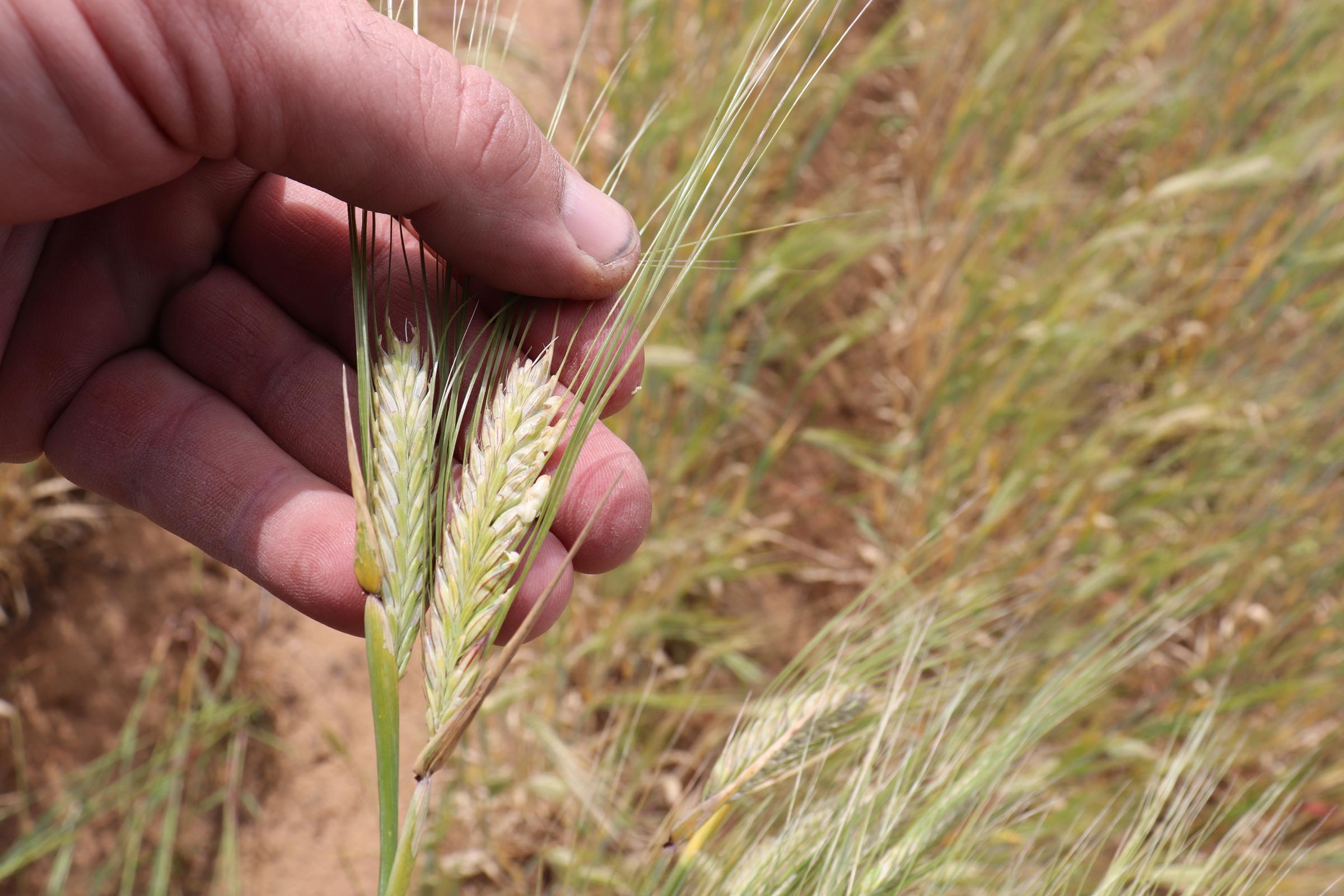BETTER DECISIONS
IN THIS ISSUE
The chance of spring frost and which regions rank the coldest Preparing for frost response New frost work from GRDCCold Mallee morning on vetch


Frost in spring of 2022 is best understood as a random process
PeterHaymanandDaneThomas,SARDIClimateApplications
Frostriskmattersineveryseason,butitisdifficulttoimaginea seasonwherethestakesareashighas2022.
Theextremelyhighinputcostscanonlybeoffsetifgrainis harvestedandsoldforpotentiallygoodprices.Evenureaprices of$1300/tonnecanbeprofitablewithwheatpricesat $400/tonne,providingthe40to50%ofthenitrogenfertiliseris recoveredinthegrain.
Abadlyfrostedcrophaslowfertiliserrecoveryastheprice receivedfromthereducedyieldwon’tbalancethehighinput costsnomatterwhathappenstograinprices.
Table1(page2)showsthenumberofnightscolderthan≤2 degreesCinthelasttwoyears.Wehaveusedfoursiteswithlong termrecordssothatwecangetasenseoftherankingofthelast twoyears.
ThesixmonthsfromMaytoOctobershowstherankings.Firstly May,JuneandJulyhavebeengroupedandthenthebusinessend oftheseasonthatincludesAugust,SeptemberandOctober. The rankingandthelongtermaverageisbasedon66wintersand65 springsforYongala,KyancuttaandMildura(since1957)and53 wintersand52springsforArarat(since1970).
WELCOME
The second issue for the year comes as we enter September, a month that brings nervous tension to many growers that live and farm in frost prone regions.
We continue our regular catch up with Dr Peter Hayman and we also check in with FAR Australia's Research Director Dr Kenton Porker to hear about the new GRDC investment in frost research.
In our podcast we also chat to Agriculture Victoria Research Agronomist Dr Jason Brand and then head to the EP to hear the latest on the season and the frost site at Tooligie with Josh Hollitt, Josh Hollitt Consulting.
Next issue due October 2022.
FROST
Knowledge to inform grower and adviser decisions for pre season planning, in season management and post frost event responses ISSUE 5 | SEPTEMBER 2022
Continued
YongalaintheUpperNorthofSouthAustraliais the coldest site followed by Ararat, Kyancutta andthenMildura.
LocalexperiencewillpointoutthatYongalaisin an elevated valley and can be bitterly cold. As expected, there are more frosts in the three months of May, June and July than August, SeptemberandOctober In2021,atallfoursites, MaytoJulyhadfewercoldnightsthanaverage andthiswasmostlikelyduetotheverywetJuly lastyear.
The11coldnightsatAraratwaslessthanhalfthe average of 24 and the second lowest number since1970
Only Kyancutta on EP had more cold nights in August to October, the other three sites experienced average or less frosty finish to the season.

The start of this winter cropping season (May, JuneandJuly)hasrecordedmorecoldnightsat Kyancutta, the average number at Yongala and fewerthanaverageatMilduraandArarat.
An obvious question is what will happen in the important months of August to October when frostscanseverelyimpactyield.
A reasonable question is whether there is any relationship between the number of cold nights early in the season (May June July) and later in theseason.
In other words, should we expect some persistenceormemoryintheseasonalfrostiness whereby seasons that start frosty tend to stay frosty.
Itisnotunreasonabletoexpectpatternsarising from persistence in weather and climate. Some seasonsseemtostartrainingandotherseasons justseemtomissout
Unfortunately using the 65 years at Kyancutta, YongalaandMilduraandthe52yearsatArarat we found no relationship. The r values that measurecorrelationarealllowandindicatethat thisprocessisbestunderstoodasrandom.
Asweshowedinthelastnewsletter,thereisnot a strong signal for frost from a negative or positiveIndianOceanDipole.
In the late 1990s, the climate scientist Neville Nicholls used to include a quote on his email signaturefromtheDrWhomovie“Ilovehumans, theycanfindpatternsinanything”.
All of us, researchers, agronomists and farmers are good at recognising patterns, that is one of oursuperpowersashumans Theproblemisthat we look for pattens that are not there in tea leaves,palmsofhandsandweatherrecords.
Table 1 Number of nights <= 2 degrees C
Continued....
Weather records are extremely useful to learn from the past, to put seasons in context and compare sites These records help us say somethingmeaningfulaboutfrostriskand,with recordsofrainfall,evaporation,radiationandhot days,tocalculateoptimalfloweringwindows.
Becausewehavetheweatherrecordswecanuse statisticstochallengeourintuitionthatafrosty starttoayearmeanssomethingaboutthefinish
Unfortunately, frost remains a real risk for the coming spring and it is best understood as random.


Projectssuchasthisthatkeepyouintouchwith growergroupsandthelatestscienceonfrostare valuable.
FollowingdevelopmentssuchasthenewGRDC projectledbyDrKentonPorkeronmanipulating crops within the season may suggest some opportunities for novel in season approaches thatmayhelpgrowersavoidfrostdamage.
Because we don’t know what will happen in springitiswisetoconsiderwaystopreparefora ‘softerfail’ratherthana‘hardfail.’ Thiswilldiffer oneachfarm Insomecases,workingouthayand grazing options and being prepared to make an assessmentofdamageafteracoldnight.
New podcast releaseBetter Frost Decisions Podcast out now!
This month we chat to:
Our regular Dr Peter Hayman, SARDI Climate Applications is back to compare the temperature in different regions. Where it is likely to be the coldest and how are the regions fairing on the frost scale in 2022? Will this affect the incidence of frost in spring?
Dr Jason Brand, Pulse Research Agronomist Agriculture Victoria, who is in the field in the Vic Mallee inspecting lentil crops. How do pulses tolerate frost?
Dr Kenton Porker, Research Director FAR Australia, on new management strategies that will be investigated as part of GRDC's new investment in frost.
Josh Hollitt, Josh Hollitt Consulting, to get an update on the Tooligie site on Eyre Peninsula and hear how the season is tracking
 Vegetative frost on barley, morning of 2 degree C
Vegetative frost on barley, morning of 2 degree C
Better Frost Decisions on Facebook -

Be prepared for a timely frost response
If you live and farm in a frost prone environment youknowalltoowellthatacropcanbethereone spring day and gone the next if an untimely frost eventoccurs. Tosupportgrowersthroughthisnervewracking timeofyear,theBetterFrostDecisionsFacebook page has been launched to provide you with access to the information you need when you needit.
Overthenextfewmonthsthisgroupwillprovide youwiththeresourcesto:
identifyfrostdamage assessyouroptionsforfrostedcrops planfornextseason reflectandreviewonthefrostevent(s)and yourresponse.
Frostexpertsandagronomistsareonstandbyto answer questions and share ongoing content using this online platform to support southern regiongrowersinthefield.


Joinouronlinefrostcommunitysowhenitcomes to making the tough decisions on frosted crops you'renotalone!
We hope you don’t need us, but if severe frost does strike this year, this group is here to provide you with up to date information about identifying and responding to frost during the 2022 season, as well as to help you plan for future seasons.
Barley frosted at grain fill
The new GRDC investment in frost is taking a differentapproachtofrostresearch,lookingbeyond genetic screening to investigate management options that may become 'farmer ready' within a shorttimeframeifproventobesuccessful.


The new project, involves some 13 research and farmingsystemgroupcollaboratorsisledbyFAR Australia'sResearchDirector,DrKentonPorker.
By 2025, the project aims to validate and quantify the opportunities in adopting a range of different in season management practices to avoidfrostdamagenationally.
Some of the practices that will be tested in conjunction with altering genetics and sowing dateandinclude:
mechanicalandchemicaldefoliation theuseofgrowthregulators theuseofcryoprotectantsandbactericides other agronomic management decisions & novelpractices.
Growers may have heard about one or more of these strategies in the past, with various claims made about their effectiveness when it comes to mitigating frostdamage
However, this project will take a deep dive into the different approaches and fine tune strategies thatmayhavepotential.
As strategies are climate dependent each region will require different strategies dependent on germination opportunity, heat and drought risk andtheabilitytoproducebiomass atsuboptimal conditions.
This work will complement other GRDC research investments,withmuchworkstilltotakeplacein beatingfrost
FAR2203 001RTX
Astrongcollaborativeresearchteamwillbeable tovalidatestrategiesindifferentenvironments.
Collaborators:FARAustralia,DPIRD,CSIRO, LivingFarm,UniversityofAdelaide,SARDI,NSW DPI,CharlesSturtUniversity,EPAgResearch, BirchipCroppingGroup,MalleeSustainable

Can we reduce frost damage in early sown crops and high-risk areas with in season management tools?
Dr Kenton Porker is leading the new frost project.
"EnhancingFrostTolerance and/orAvoidanceinwheat,barleyandcanola cropsthroughinseasonagronomicmanipulation
Farming,FrontierFarmingSystems,Federation University.
Tactics to minimise frost damage on the Eyre Peninsula update
The frost trial site at Tooligie explores an arrayoffrostmanagementstrategiesacross twodifferentfrostriskzones
These strategies include soil amelioration, phenology, time of sowing, nutrition, preventative foliar applications and crop type.
18differentcerealvarietiesand16different mixtures were sown on both 19 April (reaching GS31 32 by 23 June) and on 18 May(reachingGS31 32by3August).

Since reaching growth stage 31 the Kyancutta BoM weather station has recorded6frostevents.Downinthecanopy level at Tooligie, tiny tags recorded 19 events.
Tiny tags were also placed 5cm below the soil surface. At the ground level, temperatures were warmer in the evenings and cooler during the day, when compared totheairaroundit.
A 50cm deep Bednar ripper strip was run parallel to both the high and medium risk trials.
The canopy temperature in the ripped strip hasbeenaroundhalfadegreewarmermost nights and especially warmer during the moreseverefrostevents(28Juneand6,9, 10, 14, 15, 18, 19, 21, 24, 27, 28 July) (Figure1.).
Figure 1. Difference in canopy temperature as a result of amelioration (ripped unripped). The fluctuations follow a daily cycle, demonstrating warmer nights and cooler days.

GRDC Project code: AIP2203-001SAX Prepared by Rhaquelle Meiklejohn, EPAG Research



 Above: Frost damage already visible in August in varieties like Calibre and Vixen in the first time of sowing (19 April).
Above: Frost damage already visible in August in varieties like Calibre and Vixen in the first time of sowing (19 April).
